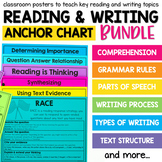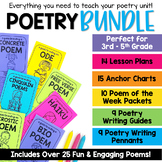Elements of Poetry Posters and Anchor Charts
What educators are saying
Also included in
- How would you like to save time and never have to create an anchor chart by hand ever again??? Get a full year's worth of Anchor Charts that are ready to print and use! This ready-to-print bundle includes over 350 anchor charts to help you teach some of the key reading, writing, grammar, and vocabulPrice $52.50Original Price $60.54Save $8.04
- Do you love teaching your poetry unit? If you're still searching for resources that will help you teach your poetry unit, you've come to the right place. This bundle gives you six poetry resources that you can use to teach your elements of poetry unit in 3rd, 4th, or 5th grade. You’ll get elementsPrice $25.50Original Price $40.55Save $15.05
Description
If you teach 3rd, 4th, or 5th grade more than likely you have to teach your students how to read and understand poetry. If you really want to help your students understand the elements of poetry this set of anchor charts is for you. These elements of poetry anchor charts and posters will help your students remember all the key elements of reading and writing poetry. These charts are great to use for your whole group lessons or to give to students to have them glue in their reading or writing journals.
This set of anchor charts will be your teacher bestie when it comes to teaching your poetry unit. These posters provide a student-firiendly definition and explanation of the key elements of poetry. And they include examples of specific types of poems for students to read and even practice writing. These posters serve as a great anchor to any poetry unit.
HERE’S WHAT YOU GET:
In this resource, you’ll get 15 Elements of Poetry Anchor Charts formatted in the following ways:
- Half-page anchor charts - perfect for students journals
- Full page anchor charts - works great for whole group lessons
- Digital version - created using Google Slides
- FIll-in version - available for both the half-page and full-page versions and are great if you want your students to take notes during the lesson
LOVED BY BOTH TEACHERS AND STUDENTS:
Your students will love having access to these anchor charts during the year. They won’t feel the pressure to remember all the different vocabulary terms connected to understanding fiction texts because they know they can look back in their journals anytime they need a reminder.
You’ll love these anchor charts because they have easy-to-read font and are written with clear and concise language. Your students will understand all the elements of fiction with these anchor charts.
So many upper elementary teachers love these anchor charts because they aren’t cluttered with excess clipart or fonts that are too “cutesy”.
And, you have options. You can choose to print them in half pages for students to glue in their journals… or you can share them with your students in Google Classroom… or you can give students the fill-in version so they can take notes during your lessons. You can pick the version that will work for you and your students.
Prep is quick and easy... Just print the anchor chart option you want to use before your lesson and you’re ready to go.
ANCHOR CHART TITLES INCLUDE:
- All About Poetry
- Prose vs. Poetry
- How Can I Study a Poem?
- Elements of Poetry
- Types of Poetry
- How to Write Poetry
- Haiku
- Diamante
- Cinquain
- Acrostic
- Concrete
- Free Verse
- Limerick
- Bio Poem
- Ode
HOW TO USE THESE CHARTS IN YOUR CLASSROOM:
- Use as a model for your whole group lessons.
- Give students a copy to glue in their journals.
- Send home a copy to parents to keep them informed.
- Include a copy with your lesson plans to show your administrators what you’re teaching.
- Put posters on a ring or in a binder as a reference for small groups or workstations.
TEACHERS LIKE YOU SAID:
⭐️⭐️⭐️⭐️⭐️ “We are still using this resource to learn how to read and write poetry. Makes teaching easy!!!” - Gerhard D.
⭐️⭐️⭐️⭐️⭐️ “I used this resource to help build the best 2-week poetry unit I have ever taught!” - Wendy’s Words
⭐️⭐️⭐️⭐️⭐️ “Poetry has always been a struggle for my students and this resource really helped them gain a deeper understanding. Thank you.” - Ashley B.
⭐️⭐️⭐️⭐️⭐️ “My students love these poetry interactive notebook inserts. I use them when I introduce poetry and reference them throughout the year.” - Kimberly G.
_______________________________________
⭐️ BUNDLE & SAVE FOR A DISCOUNT⭐️
Purchase the Poetry Bundle to get this set of posters plus poetry writing guides and other resources to help your students read and write poetry.
I THINK YOU MIGHT ALSO LIKE:
→ Figurative Language Weekly Activity
→ Picture of the Day - Elements of Fiction Bundle
________________________________
Copyright © The Stellar Teacher Co. LLC
www.stellarteacher.com
Permission to copy for single classroom use only.
Please purchase additional licenses if you intend to share this product.







